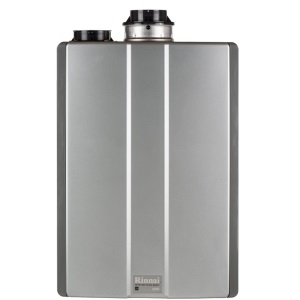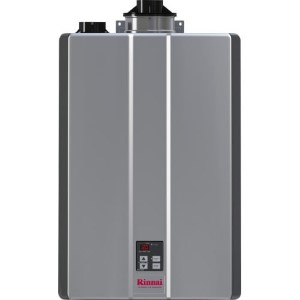- Home
- Tankless water heaters
- How to Prepare a Tankless Water Heater for Winter
How to Prepare a Tankless Water Heater for Winter
How to prepare a tankless water heater for winter and avoid heat exchanger freezing, bursting, no hot water, and other problems.
Either you are using an indoor or outdoor unit, you should be familiar with winterizing a tankless water heater. Outdoor models are much more affected by the freezing winter temperatures, but indoor models can also be impacted. This is why installing a unit in the proper location with the correct venting is very important.
 Rinnai tankless water heater
Rinnai tankless water heaterA step-by-step guide on how to winterize a tankless water heater
- Turn the water heater OFF and unplug the power cord.
- Shut the gas and water supply OFF.
- Open hot water tap to drain water.
- After the water pressure has been lowered, disconnect the outlet and inlet water pipes and put the bucket underneath to collect the remaining water.
- Use the air compressor to blow the outstanding water.
- Place a cover over the vent termination if possible. It should be done on both intake and exhaust to prevent debris or leaves from entering the venting system.
Built-in freeze protection
Most of the modern tankless water heaters are equipped with a freeze prevention system designed to protect the water heater during the wintertime. This applies for short-term conditions only and not for areas where the long-term freezing is "normal."
The system protects the unit only, not the plumbing outside. For example, Bosch models have the freeze protection built-in that works for temperatures down to 5 F. Rinnai manufacturer, on the other side, incorporates a system that can protect the units from freezing when the outside temperature of the air is up to -22 F for indoor, and -4 F for outdoor models. This works as long as the electric power is supplied and units are protected from direct-wind exposure.
The most used feature is the freeze-prevention heater, which requires the power cable constantly plugged into the wall outlet. No matter if the operation switch is in an ON or OFF position, the heater automatically turns ON to protect the unit.
- Find Plumbers In Your Area -
Tips to consider
- Either you are installing a concentric or dual-vent system, try to stay away from facing the vent pipes in the wind direction as it can lower the temperature - the effect of the "wind chill."
- Condensate drain tubing should not be installed in the area where it might freeze. It is recommended to install a drain pipe in the wall, for example.
- Components in tankless water heaters (especially a heat exchanger) can freeze due to the negative draft in the venting. The negative draft happens when the furnace, for example, or any gas-powered device, takes the air supply from the water heater vent pipe, so the cold air enters the system and freezes the water in the heat exchanger. One solution for this problem, which will also help you prepare a tankless water heater for winter properly, is to provide a sufficient supply of combustion air for all gas-powered appliances in the building.
- Another solution from Bosch is the backdraft reducer, which closes the internal flapper to limit the backdraft.
- In the case of freezing weather, protect the unit by opening the hot water tap and keep a small stream of hot water running (i.e., 4 mm thick). Before that, turn the power OFF and close the gas supply valve. This way, you will protect not only a heater but piping also.
Here is a simple test to check for the negative draft
- Close all the windows and doors in your home.
- Run all the fuel-powered appliances except the tankless for an hour.
- Light the match or candle and hold it close to the opening of the draft hood and exhaust vent louvers. What you should see is the smoke sucked in quickly and not coming back.
In the event of a power outage or absence during the cold winter period, the water heater should be drained. If you don't take precautions, a water heater can get damaged, which will void your warranty. My recommendation is to follow the above tips and read the manufacturer's manual, but avoid using anti-freeze chemicals for protection as it might damage the internal components.
Related
- Home
- Tankless water heaters
- How to Prepare a Tankless Water Heater for Winter



